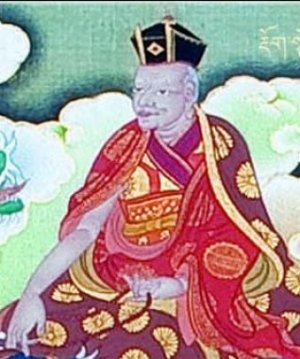| Library / Biographies |
Phagmo Drupa Dorje Gyalpo Biography

Phagmodrupa with His Previous Incarnations and Episodes from His Life, 14th-century painting from the Rubin Museum of Art,United States.Phagmo Drupa Dorje Gyalpo (1110-1170), was one of the three main disciples of Gampopa Sonam Rinchen who established the Dagpo Kagyu school of Tibetan Buddhism, and also a disciple of Sachen Kunga Nyingpo (1092-1158) one of the founders of the Sakya school of Tibetan Buddhism.
He was the elder brother of Kathog Dampa Deshek (1122-1192), who founded Kathog monastery and the Kathog branch of the Nyingma school.
Phagmo Drupa was born in southern Kham to a family of the Wa We-na clan. His parents died when he was seven years old and he was taken care by his paternal uncle, a monk who helped with his education. He demonstrated a talent for calligraphy, reading and writing.
At age eighteen he travelled to U-Tsang, where he spent most of his life. He studied the Kadampa and related teachings. He met Düsum Khyenpa when they were studying under illustrious scholar Gyamarpa in Tölung.
He took the monastic ordination in 1138 at age twenty-eight. He met Sachen Kunga Nyingpo (1092-1158)1, a renowned Sakya master, and studied with him for twelve years.
In 1151, at age forty-one Phagmo Drupa met Gampopa Sonam Rinchen who was 72 years old, at his seat, Daklha Gampo. Initially, Gampopa did not receive him and he had to spend few days building a shelter. After that he received instruction on Mahamudra and achieved profound experience.
After Gampopa’s death in 1153, Phagmo Drupa went to meditate in wilderness areas. A hermit gave him his meditation hut near the city of Tsetang, a place where the monastery of Densatil was later built. He stayed there from 1158 until his death in 1170.2
The lineage of Phagmo Drupa, Pagdru Kagyu includes all the lineages established by his disciples:
• Drukpa Kagyu, was founded in west Tibet by Tsangpa Gyare (1161–1211), a student of Ling Repa, who mastered the Vajrayana practices of the Mahamudra and Six Yogas of Naropa at an early age. As a tertön or "finder of spiritual relics", he discovered the text of the Six Equal Tastes, previously hidden by Rechung Dorje Drakpa, the student of Milarepa.
• Drikung Kagyu was founded by Jikten Sumgon (1143-1217). The lineage takes its name from Drigung Monastery founded by Jigten Sumgön, also known as Drikung Kyopa. The special Kagyu teachings of the Drikung tradition include the "Single Intention", "The Essence of Mahāyāna Teachings", and the "Fivefold Profound Path of Mahāmudrā." Since the 15th century the Drikung Kagyupa received influence from the "northern terma" teachings of the Nyingma tradition.
• Taglung Kagyu named after Taklung Monastery established in 1180 by Taklung Thangpa Tashi Pal (1142–1210).
• Martsang Kagyu founded by Marpa Sherab Yeshe (1135-1203).
• Shukseb Kagyu founded by Gyergom Chenpo Zhönnu Drakpa (1144-1204).
• Tropu was established by Gyeltsa Rinchen Gön (1118–1195) and Künden Repa (1148–1217). The tradition was developed by their nephew, Thropu Lotsawa, who invited Pandit Shakyasri of Kashmir, Buddhasri and Mitrayogin to Tibet.
• Yabzang Kagyu was founded by Sharawa Kalden Yeshe Sengge (d. 1207). His foremost disciple was Yazang Chöje Chö Mönlam (1169–1233) who in 1206 established the monastery of Yabzang, also known as Nedong Dzong, in Yarlung. The Yazang Kagyu survived as an independent school at least until the 16th century.
• Yelpa Kagyu was founded by Druptop Yéshé Tsekpa (b. 1134). He established two monasteries, Shar Yelphuk and Jang Tana.
Sources
• https://treasuryoflives.org
• https://en.wikipedia.org/wiki/Phagmo_Drupa_Dorje_Gyalpo
• The Vagrant Poet and The Reluctant Scholar, W. Blythe Miller
Footnotes
1. Sachen Kunga Nyingpo was a Tibetan spiritual leader and the first of the Five Venerable Supreme Sakya Masters of Tibet. Sachen Kunga Nyinpo was the 3rd Sakya Trizin and son of Khon Konchok Gyalpo (1034–1102) who was the first Sakya Trizin and founder of the first Sakya Monastery in Tibet in 1073.
2. “This pattern of sending the best monks out again and again for meditation in various rural environments and non-Buddhist areas actually turned them into de facto missionaries and was one of the most important means for the Kagyiipa to build its patronage and spread its lineage.
When such charismatic figures as Diisum Khyenpa or Pagmo Drupa appeared in an area unused to Sarma monks, villagers would hear of the strange saint with an arresting gaze, and everyone would flock to see whether the saint would use his psychic powers to help them find their cattle or cure their children of disease.
Over time, religious supremacy was achieved by a thousand appearances, and the fame of Kagyiipa meditators, especially of the three disciples of Gampopa - Diisum Khyenpa, Barompa, and Pagmo Drupa—spread to the Tangut kingdom.” (R. Davidson, Tibetan Tantric Buddhism in the Renaissance)





